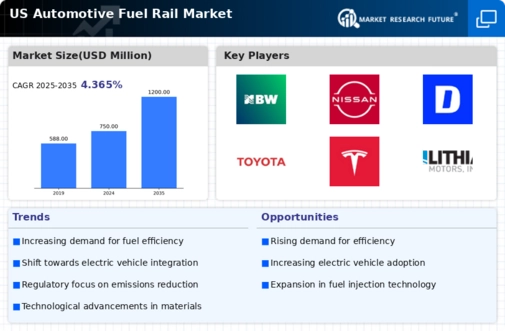The US Automotive Fuel Rail Market is characterized by a competitive landscape that is shaped by the presence of established players and emerging companies engaged in the design, manufacturing, and supply of fuel rail systems. With increasing vehicle production and the growth of the automotive industry, this market has also seen heightened focus on innovation, efficiency, and environmental sustainability. Companies operating in this space are consistently striving to differentiate their products through advanced technologies that enhance fuel efficiency, reduce emissions, and cater to the specific needs of automotive manufacturers.
The competitive dynamics are influenced by factors such as market demand for gasoline and alternative fuel vehicles, evolving regulatory standards, and the necessity for collaboration among industry players to meet the challenges posed by shifting consumer preferences and technological advancements.BorgWarner has emerged as a formidable competitor within the US Automotive Fuel Rail Market, leveraging its extensive experience and expertise in the field of powertrain solutions. The company is recognized for its commitment to delivering high-quality fuel rail systems that are integral to automotive performance and efficiency.
BorgWarner's strengths lie in its innovative product offerings, which incorporate advanced materials and technologies designed to optimize fuel delivery and improve engine performance. Their robust market presence is supported by a diversified portfolio and strong relationships with leading automotive manufacturers in the US. This company has also focused on research and development, ensuring it stays ahead of market trends while addressing the demands of a changing regulatory landscape concerning emissions and fuel efficiency.Nissan is a significant player in the US Automotive Fuel Rail Market, known for its commitment to producing high-performance vehicles that require advanced fuel delivery systems.
In this market, Nissan's strengths stem from its diverse product range that includes fuel rails designed for various engine configurations, thereby catering to both traditional internal combustion engines and newer hybrid models. The company has a strong market presence backed by extensive distribution channels and strategic partnerships that enhance its competitive edge. Additionally, Nissan has made strides in mergers and acquisitions, establishing collaborations that bolster its capabilities in fuel rail technology while improving overall manufacturing efficiency.
By innovating around key products and refining its service offerings, Nissan aims to align with industry trends towards sustainability and enhanced vehicle performance in the US.
























